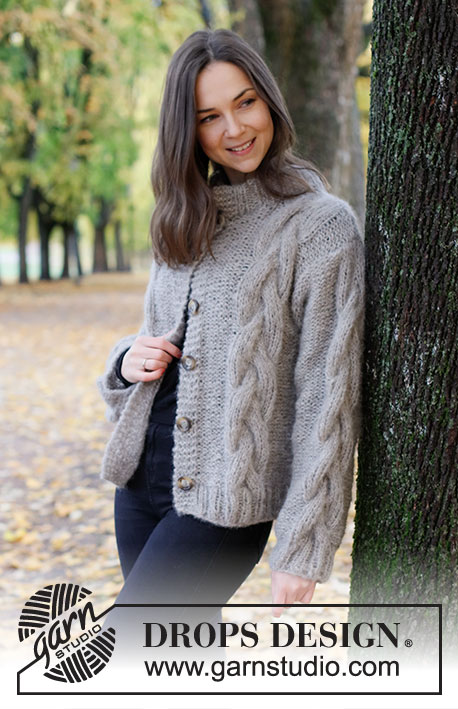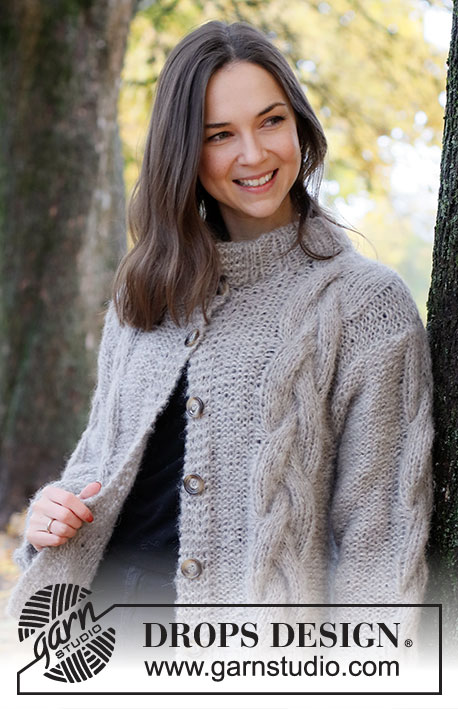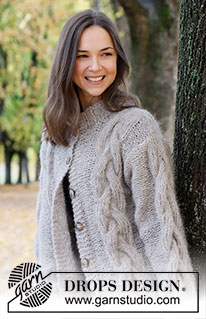Comments / Questions (12)
![]() Sian wrote:
Sian wrote:
For A2 is cable stitch knitted on row 1 and then 7 rows of purl and knit on alternate rows or is cable on every row? I am confused .
01.11.2024 - 23:06DROPS Design answered:
Dear Sian, the cables are worked in rows 3 and 11 of the repeat. Both rows have a different type of cable stitches; you can see the explanations in the Diagram explanations. The rows in-between are worked back and forth in stocking stitch: knit from right side and purl from wrong side. Happy knitting!
03.11.2024 - 13:21
![]() Anna Christensen wrote:
Anna Christensen wrote:
Er der ikke mønster på ryggen ?
20.10.2024 - 15:03
![]() Nancy wrote:
Nancy wrote:
Hello, since A1 (10 sts) is changed to A2 (15 sts) on the RS, is A2 worked on the next row, WS? Thank you.
13.12.2023 - 16:12DROPS Design answered:
Dear Nancy, A.1 is worked over 2 rows: first row is worked with increases from RS and 2nd row is worked from wrong side. A.2 starts from right side. Happy knitting!
13.12.2023 - 16:26
![]() Lena wrote:
Lena wrote:
Hvilken størrelse skal snoningspinden være?
17.10.2023 - 18:39DROPS Design answered:
Hej Lena, det betyder ikke så meget, men hvis du har flere så vælg en omkring pind 6 :)
18.10.2023 - 07:25
![]() Karin wrote:
Karin wrote:
Hoe brei ik de mouw kop van dit patroon? Staat in de beschrijving maar niet duidelijk voor mij. Patroon tekening geeft een rechte bovenkant aan.
11.10.2023 - 18:46DROPS Design answered:
Dag Karin,
Er zit geen ronde mouwkop aan de mouw. De mouw wordt wel a.h.w. een stukje in het pand geschoven, dat kun je zien aan de inham bij de oksel in de tekening. Dus een stukje van de onderarmnaad wordt tegen de mouwopening op het pand genaaid.
11.10.2023 - 19:17
![]() Betty wrote:
Betty wrote:
Bonjour, Je souhaite faire ce modèle avec des aiguilles droites, pourriez-vous m'aider à le convertir ? Je sais que je dois ajouter une maille lisière de chaque côté (donc deux mailles en tout) pour le dos et le devant, ça, ça reste simple... Comment puis-je faire pour le reste ? Les motifs et autres sont inchangés ? Dois-je tricoter différent (endroit/envers) avec des aiguilles droites ? Je suis un peu perdue ! Merci pour votre aide !
15.04.2023 - 17:49DROPS Design answered:
Bonjour Betty, comme le dos et les devants se tricotent en allers et retours sur aiguille circulaire en une seule partie, vous n'avez pas besoin de rajouter de mailles lisières, suivez simplement les indications telles qu'elles sont. Pour les manches, vous devrez juste ajouter 1 m lis de chaque côté. - pensez à les rabattre quand vous commencez le haut de la manche. Bon tricot!
17.04.2023 - 09:06
![]() Anita wrote:
Anita wrote:
Hallo liebes Drops Team,\r\nIch denke da stimmt was mit dem Ärmel nicht. Es steht Anschlag 40 Maschen, danach bei A1 2x 4 Maschen zunehmen, dann sollten total 53 Maschen sein aber das sind ja erst 48. Habe ich etwas übersehen? \r\nLiebe Grüße\r\nAnita
17.02.2023 - 22:48
![]() Silke Blechschmidt wrote:
Silke Blechschmidt wrote:
Hallo Team Drops, das ist eine wunderbare Jacke! Können Sie sagen, wieviel Gramm Wolle man mehr benötigt, wenn man die Jacke als Longjacke/Mantel arbeitet, also oberschenkellang in der Größe XL? \r\nVielen Dank.\r\nViele Grüße
26.02.2022 - 12:31
![]() Stacey wrote:
Stacey wrote:
Thank you @DROPS Design team!
16.10.2021 - 13:13
![]() Stacey wrote:
Stacey wrote:
Hello, I am willing to knit this piece using 1 strand of Brushed Alpaca Silk and 1 strand of Big Merino in size M. Could you tell me how much yarn I will need?
15.10.2021 - 14:46DROPS Design answered:
Dear Stacey, the jacket is worked with 2 strands Brushed Alpaca Silk, divide the amount in 2 and use this amount to convert into Big Merino with the help of our yarn converter. Happy knitting!
15.10.2021 - 16:16
Evening Fires Jacket#eveningfiresjacket |
||||||||||||||||
 |
 |
|||||||||||||||
Knitted jacket in 2 strands DROPS Brushed Alpaca Silk or 1 strand DROPS Wish. Piece is knitted with cables, double neck edge and ribs. Size: S - XXXL
DROPS 226-39 |
||||||||||||||||
|
---------------------------------------------------------- EXPLANATION FOR THE PATTERN: ---------------------------------------------------------- GARTER STITCH (back and forth): Knit all rows. 1 ridge vertically = knit 2 rows. PATTERN: See diagrams A.1 and A.2. Diagrams show all rows in pattern seen from the right side. BUTTONHOLES: Decrease for buttonholes on right band. 1 BUTTONHOLE = knit third and fourth stitch from edge together and make 1 yarn over. On next row knit yarn over to make hole. Decrease for buttonholes when piece measures: S: 5, 13, 21, 29, 37 and 45 cm. M: 5, 13, 21, 29, 38 and 47 cm. L: 5, 13, 22, 31, 40 and 49 cm. XL: 5, 14, 23, 31, 41 and 51 cm. XXL: 5, 14, 23, 33, 43 and 53 cm. XXXL: 5, 15, 25, 35, 45 and 55 cm. INCREASE TIP: Work until 2 stitches remain before marker thread, make 1 yarn over, knit 4 (marker thread is in the middle of these 2 stitches), make 1 yarn over. On next round purl yarn overs twisted to avoid holes = 2 stitches increased. Then purl the new stitches. ---------------------------------------------------------- START THE PIECE HERE: ---------------------------------------------------------- JACKET - SHORT OVERVIEW OF THE PIECE: Piece back and forth on circular needle from mid front, from the bottom and up to armholes, then divide the piece and finish front piece and back piece separately. Work sleeves in the round on a short circular needle/double pointed needles, bottom up . BODY: Cast on 116-124-132-140-148-156 stitches on circular needle size 6 mm with 2 strands DROPS Brushed Alpaca Silk or 1 strand DROPS Wish. Purl 1 row from wrong side. Then work rib as follows – from right side: 5 band stitches in GARTER STITCH - read explanation above - * knit 2 / purl 2 *, work from *-* until 7 stitches remain, knit 2 and 5 band stitches in garter stitch. At the same time when piece measures 5 cm, begin decrease for BUTTONHOLES - read explanation above! Continue with rib until piece measures 6 cm, switch to circular needle size 8 mm. Continue as follows– from right side: 5 band stitches in garter stitch, purl 8. A.1 (= 10 stitches that are increased to 15 stitches), purl 14-18-22-26-30-34, A.1, purl 6, A.1, purl 6, A.1, purl 14-18-22-26-30-34, A.1, purl 8, 5 band stitches in garter stitch. When A.1 has been worked 1 time vertically, there are 141-149-157-165-173-181 stitches on needle. Continue with A.2 (= 15 stitches) over every A.1, work the remaining stitches as before. Continue pattern like this. REMEMBER THE KNITTING TENSION! When piece measures 30-31-32-33-34-35 cm, divide the piece for front pieces and back piece. Work next row as follows: Work 34-36-38-40-42-44 stitches, cast off 4 stitches for armhole, work 65-69-73-77-81-85 stitches, cast off 4 stitches for armhole, work the last 34-36-38-40-42-44 stitches. Each part is worked separately back and forth on needle. Slip the first and last 34-36-38-40-42-44 stitches on a stitch holder, and then work over the 65-69-73-77-81-85 stitches on back piece. BACK PIECE: = 65-69-73-77-81-85 stitches. Work as follows - from right side: Purl 4-6-8-10-12-14, A.2, purl 6, A.2, purl 6, A.2, purl 4-6-8-10-12-14. When piece measures 49-51-53-55-57-59 cm, decrease 5 stitches over middle repetition of A.2, on next row cast off the middle 14-16-18-20-22-24 stitches for neck, and finish each shoulder separately. Then cast off 1 stitch on next row from neck = 22-23-24-25-26-27 stitches. Work the stitches in A.2 in stocking stitch, decrease at the same time 5 stitches evenly over these stitches = 17-18-19-20-21-22 stitches. Cast off when piece measures 52-54-56-58-60-62 cm (= 22-23-24-25-26-27 cm from division for armholes). Work the other shoulder the same way. LEFT FRONT PIECE: Slip the first 34-36-38-40-42-44 stitches back on circular needle size 8 mm. Work as follows - from right side: Purl 6-8-10-12-14-16, A.2, purl 8, 5 stitches in garter stitch. When piece measures 46-48-50-52-54-56 cm, slip the outermost 8-9-10-11-12-13 stitches towards mid front on a stitch holder for neck, work them before slipping them on stitch holder to avoid cutting the yarn. Then cast off stitches on every row from neck as follows: Cast off 2 stitches 1 time and 1 stitch 2 times = 22-23-24-25-26-27 stitches remain on shoulder. Work the stitches in A.2 in stocking stitch, decrease at the same time 5 stitches evenly over these stitches = 17-18-19-20-21-22 stitches. Cast off when piece measures 52-54-56-58-60-62 cm (= 22-23-24-25-26-27 cm from division for armholes). RIGHT FRONT PIECE: Slip the last 34-36-38-40-42-44 stitches back on circular needle size 8 mm. Work as follows - from right side: 5 stitches in garter stitch, purl 8, A.2, purl 6-8-10-12-14-16. When piece measures 46-48-50-52-54-56 cm, slip the outermost 8-9-10-11-12-13 stitches towards mid front on a stitch holder for neck, work them before slipping them on stitch holder to avoid cutting the yarn. Then cast off stitches on every row from neck as follows: Cast off 2 stitches 1 time and 1 stitch 2 times = 22-23-24-25-26-27 stitches remain on shoulder. Work the stitches in A.2 in stocking stitch, decrease at the same time 5 stitches evenly over these stitches = 17-18-19-20-21-22 stitches. Cast off when piece measures 52-54-56-58-60-62 cm (= 22-23-24-25-26-27 cm from division for armholes). SLEEVE: Work sleeves in the round on double pointed needles/a short circular needle and bottom up. Cast on 32-32-36-36-40-40 stitches on double pointed needles size 6 mm with 2 strands Brushed Alpaca Silk or 1 strand DROPS Wish. Knit 1 round, then work rib as follows: SIZE S-M-XXL-XXXL: Knit 1, * purl 2, knit 2 *, repeat from *-* over the next 30-30-38-38 stitches, finish with knit 1. SIZE L-XL: Purl 1, * knit 2, purl 2 *, repeat from *-* over the next 34-34 stitches, finish with purl 1. Work rib for 6 cm, switch double pointed needles size 8 mm. Work next round as follows: Purl the first 11-11-13-13-15-15 stitches, at the same time increase 3-4-3-4-3-4 stitches evenly over these stitches, A.1, purl the last 11-11-13-13-15-15 stitches, at the same time increase 3-4-3-4-3-4 stitches evenly over these stitches. When A.1 has been worked 1 time vertically and the increases have been done evenly, there are 43-45-47-49-51-53 stitches on needle. Continue with A.2 over stitches in A.1 and purl as before. Insert a marker thread at beginning of round = mid under sleeve. When piece measures 8 cm, increase 1 stitch on each side of marker thread - read INCREASE TIP. Increase every 9-9-9-8-8-8 cm 5 times in total in every size = 53-55-57-59-61-63 stitches. When sleeve measures 49-48-47-46-45-44 cm, work sleeve cap back and forth (from mid under sleeve) on circular needle until finished measurements. When piece measures 50-49-48-47-46-45 cm, decrease 5 stitches evenly over stitches in A.2. Work until sleeve measures approx. 51-50-49-48-47-46 cm, i.e. there is a vent of 2 cm at the top of sleeve. Work another sleeve the same way. ASSEMBLY: Sew the shoulder seams. Sew sleeve cap to armhole. Then sew vent at the top of sleeve to bottom of armhole - see chart. Sew the buttons on to left front piece. NECK EDGE: Begin mid front and from right side, and pick up approx. 48-68 stitches (number of stitches should be divisible by 4) around the neck (including stitches on stitch holders) on circular needle size 6 mm with 2 strands Brushed Alpaca Silk or 1 strand DROPS Wish. Work rib as follows – first row is worked from wrong side: 5 band stitches in garter stitch, purl 2, * knit 2, purl 2 *, work from *-* until 5 stitches remain, and work 5 band stitches in garter stitch. Work rib for 12 cm. Loosely cast off stitches with knit over knit and purl over purl. Fold rib at the top of neck down on inside of garment. Fasten the rib to get a double neck edge, and sew opening in each side towards mid front. To avoid a tight neck edge that sticks out it is important to keep the seam elastic. |
||||||||||||||||
Diagram explanations |
||||||||||||||||
|
||||||||||||||||

|
||||||||||||||||

|
||||||||||||||||

|
||||||||||||||||
Have you finished this pattern?Tag your pictures with #dropspattern #eveningfiresjacket or submit them to the #dropsfan gallery. Do you need help with this pattern?You'll find 28 tutorial videos, a Comments/Questions area and more by visiting the pattern on garnstudio.com. © 1982-2025 DROPS Design A/S. We reserve all rights. This document, including all its sub-sections, has copyrights. Read more about what you can do with our patterns at the bottom of each pattern on our site. |
||||||||||||||||












































































Post a comment to pattern DROPS 226-39
We would love to hear what you have to say about this pattern!
If you want to leave a question, please make sure you select the correct category in the form below, to speed up the answering process. Required fields are marked *.